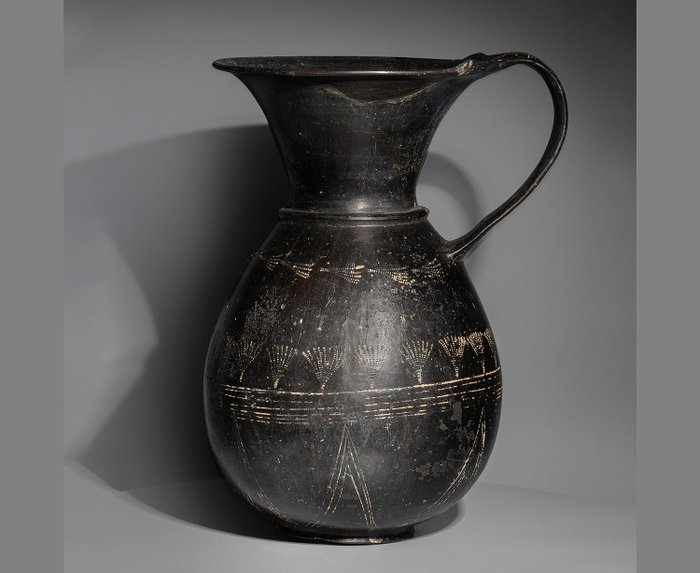
Etrusker Keramik Funerary Neck Amphora med Chimera og Achlae af Micali-maleren. 5. århundrede f.Kr. 35 cm Højde.
Nr. 82481995

Nr. 82481995

Olpe in Bucchero.
Etruscan, 6th - 5th century BC.
Pottery
22 cm H.
Condition: Good state of preservation, it presents a reconstruction in the upper lateral part of the lip, the rest intact.
Provenance: Private collection, Leiden, The Netherlands. Acquired around 1993.
Description:
The vessel under study is an Olpe, a type of vessel originating in Greek pottery used to to hold water, wine, or any other liquid. It is characterised by a single handle and is classified according to the shape of the mouth and belly. This shape, with the vertical rosettes on both sides of the handle that appear on the piece under study, was widely used by Etruscan potters.
Etruscan production of the bucchero pottery is clearly identifiable by its characteristic dark, shiny surface. Developed from around 675 BC onwards from the local pottery tradition, the bucchero type is made from a very refined clay, free of impurities, of better quality than that used by the preceding Villanova Culture. The vessels were worked on a potter's wheel, after which the surface was burnished, closing the pores of the clay, and they were fired in a reducing atmosphere, with very little oxygen, resulting in the dark colour so typical of this type of production. These pieces were inspired by silverware, hence their monochrome, shiny appearance, their often angular shapes and the way the decorative motifs were worked, always in relief or incised. The very arrangement of the ornamentation on many of these pieces, forming bands, is also reminiscent of contemporary metalwork, especially the gold and silver vessels imported from Egypt and the Near East. It also appears that some of these vessels were decorated with silver-plating, which brings them even closer to their metal models.
The bucchero pesante is a later form of the bucchero, and is characterised by thicker walls and more flattened shapes than its predecessor, the so-called bucchero sottile by comparison. The pesante was mainly decorated with moulded figures applied to the vessel while the clay was still wet.
The decoration of the bucchero was mainly geometric; the number of known vases with animal friezes barely exceeds 100, representing only a small proportion of the total. Nevertheless, animal motifs appear in the earliest expressions of the style, in the second quarter of the 7th century BC, and would remain in use until at least the second quarter of the 6th century BC, precisely the period to which the piece under study can be dated. Animal motifs rarely appear alone on the buccaneer, but form friezes framed by bands of roulettes, incised lines or relief mouldings.
NOTES:
The Seller can prove that the lot was obtained legally , provenance statement seen by Catawiki.
Important information. The seller guarantees that he is entitled to ship this lot.
- The piece includes authenticity certificate.
- The piece includes Spanish Export License.
- The seller guarantees that he acquired this piece according to all national and international laws related to the ownership of cultural property. Provenance statement seen by Catawiki.
Sådan køber du hos Catawiki
1. Opdag noget særligt
2. Afgiv det højeste bud
3. Foretag en sikker betaling